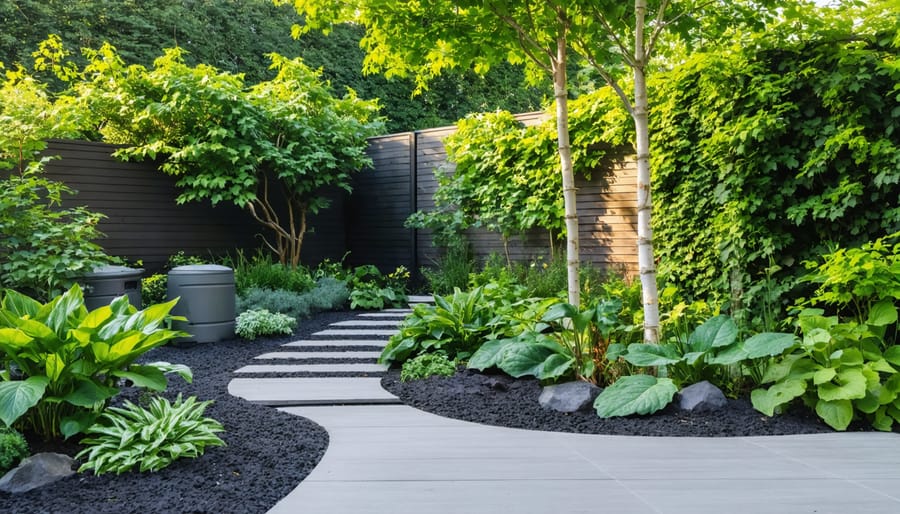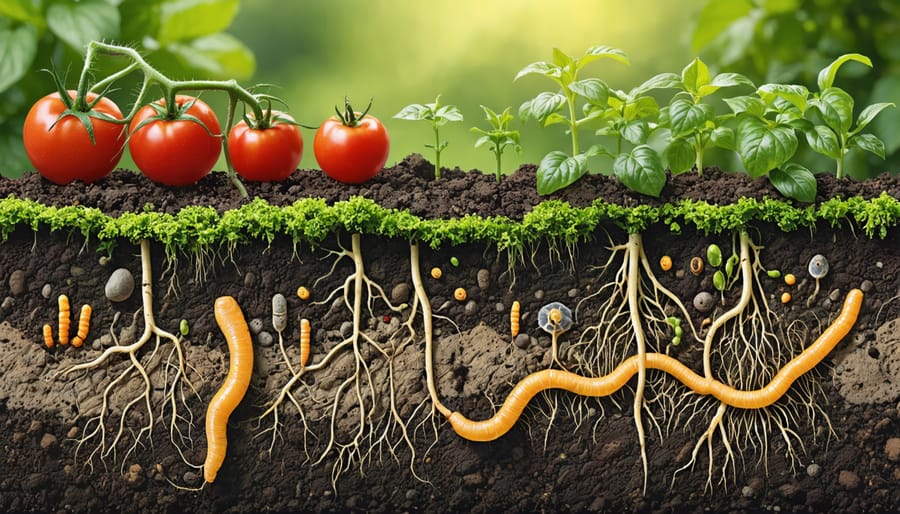Transform your garden’s water efficiency by mastering three fundamental techniques that professional landscapers rely on daily. Install drip irrigation systems beneath mulch layers to deliver water directly to root zones, reducing evaporation losses by up to 70% compared to traditional sprinklers. Group plants with similar water needs together in hydrozones, creating efficient watering schedules that prevent both over-and under-watering while cutting water bills significantly. Capture and store rainwater in strategic collection points using rain barrels or underground cisterns, providing a free, natural water source that plants thrive on during dry spells.
Modern water management combines these time-tested methods with smart technology, allowing gardeners to monitor soil moisture levels and automate irrigation schedules. Whether you’re tending a small herb garden or managing extensive landscaping, these water-wise practices help create resilient, sustainable gardens that flourish even in challenging conditions. The key lies in understanding your garden’s specific needs and implementing systems that work in harmony with natural water cycles.
Understanding Your Garden’s Water Needs
Soil Type and Water Retention
Understanding your garden’s soil health and composition is crucial for effective water management. Different soil types have varying abilities to hold and distribute water, which directly impacts how you should water your garden.
Sandy soils drain quickly and don’t retain water well, requiring more frequent but shorter watering sessions. Think of sandy soil like a sieve – water passes through rapidly, so plants might need watering every few days to stay healthy.
Clay soils, on the other hand, hold water like a sponge but can become compacted and waterlogged. While you won’t need to water as frequently, it’s important to water slowly to allow proper absorption and prevent runoff.
Loamy soil strikes the perfect balance, offering ideal water retention and drainage. If you’re blessed with loamy soil, you’ll find it easier to maintain consistent moisture levels with regular, moderate watering.
To improve any soil’s water retention, try adding organic matter like compost or mulch. This simple step can transform your soil’s ability to hold moisture while nourishing your plants.
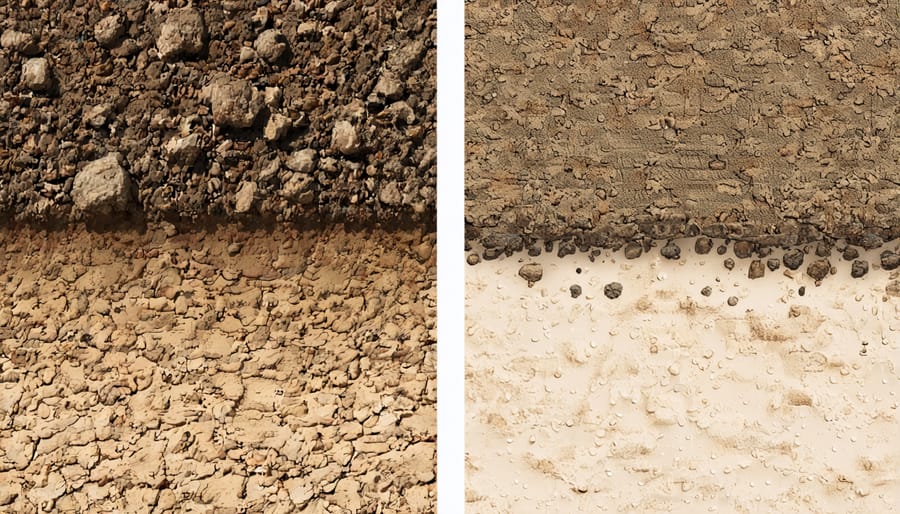
Plant-Specific Requirements
Different plants have unique water requirements that change throughout their growth cycles. Seedlings and young plants typically need frequent, light watering to establish strong root systems, while mature plants often prefer deeper, less frequent watering that encourages roots to grow deeper into the soil.
Desert plants like succulents and cacti thrive with minimal water and excellent drainage, requiring watering only when their soil is completely dry. In contrast, moisture-loving plants such as ferns and hydrangeas need consistently damp soil and may require daily watering during hot weather.
Vegetable gardens have varying needs based on their growth stages. Leafy greens need regular, light watering, while deep-rooted vegetables like tomatoes and squash benefit from thorough, less frequent watering. Fruit trees require different watering patterns throughout the year – more water during fruit development and less during dormancy.
Always check soil moisture before watering by inserting your finger about an inch into the soil. If it feels dry at that depth, it’s time to water. Remember that seasonal changes and local climate conditions will affect how often you need to water your plants.
Smart Watering Methods That Save Time and Money
Drip Irrigation Systems
Drip irrigation is a game-changer for gardeners looking to save water while keeping their plants happy and healthy. This efficient system delivers water directly to plant roots through a network of tubes and emitters, reducing water waste by up to 70% compared to traditional watering methods.
Setting up a drip system is simpler than you might think. Start with a timer-equipped water source, attach a pressure regulator and filter, and run a main water line through your garden. From there, smaller distribution tubes with emitters branch off to individual plants. You can customize the flow rate and spacing to meet different plants’ needs – perfect for mixed gardens with varying water requirements.
The benefits are impressive: reduced water bills, fewer weeds (since you’re not watering empty spaces), and healthier plants with consistent moisture levels. Plus, you’ll spend less time watering and more time enjoying your garden! Many gardeners report that their plants thrive with drip irrigation because it maintains ideal soil moisture without creating wet leaves that can lead to disease.
For best results, cover your drip lines with mulch to prevent water evaporation and protect the tubes from sun damage. Regular maintenance is minimal – just check for clogs and leaks seasonally, and flush the system occasionally to prevent mineral buildup. With proper care, a drip system can serve your garden faithfully for many years while conserving our precious water resources.
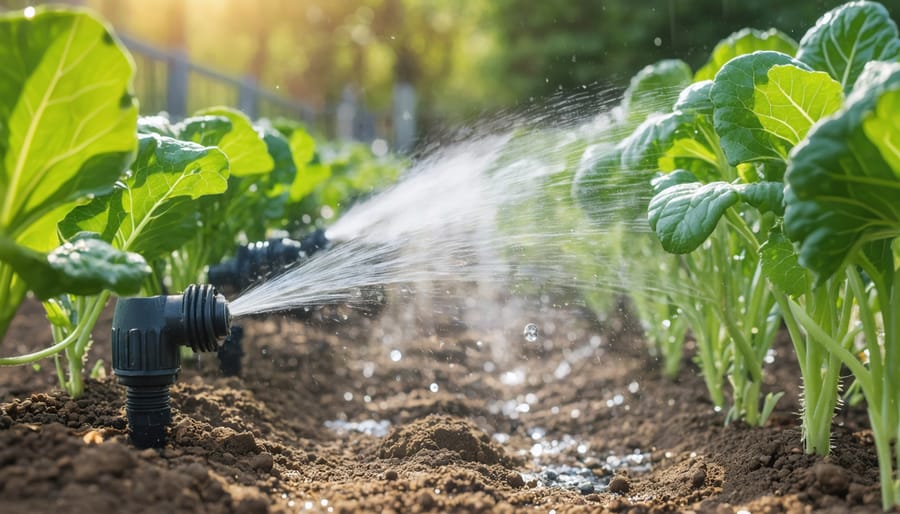
Soaker Hoses and Their Strategic Placement
Soaker hoses are a gardener’s best friend when it comes to efficient water management. These porous rubber hoses allow water to seep directly into the soil, delivering moisture right to your plants’ root systems. The key to success lies in their strategic placement and proper installation.
For optimal results, place soaker hoses about 2-3 inches away from plant stems and cover them with a layer of mulch. This placement ensures water reaches the roots while preventing evaporation. In vegetable gardens, run the hoses along plant rows, and for flower beds, create a serpentine pattern to cover more ground.
Remember to keep the hose lengths under 100 feet per zone, as longer runs can result in uneven water distribution. Position the hoses on level ground when possible, as steep slopes can cause water to run downhill rather than seeping into the soil where needed.
Connect your soaker hoses to a timer for even better efficiency. This automation helps maintain consistent soil moisture and prevents both under and overwatering. Start with 30-minute sessions twice a week, then adjust based on your plants’ needs and soil conditions.
Pro tip: Before covering your soaker hoses with mulch, run them for a few minutes and observe the water distribution pattern. This test run helps identify any potential dry spots or areas needing adjustment.
Smart Controllers and Automated Systems
Modern gardening has embraced technology to make water management more efficient and hassle-free. Smart controllers and automated systems have revolutionized the way we approach garden irrigation, taking the guesswork out of when and how much to water our plants.
These intelligent systems typically include weather-based controllers that automatically adjust watering schedules based on local weather conditions. They can detect rainfall, humidity, and temperature changes, ensuring your garden receives just the right amount of water. Some advanced models even connect to your smartphone, allowing you to monitor and adjust your watering equipment from anywhere.
Soil moisture sensors are another game-changing addition to automated systems. These small devices are placed in different garden zones and communicate with your controller to prevent overwatering or underwatering. When the soil becomes too dry, the system activates; when it’s sufficiently moist, it holds off on watering.
For container gardens or smaller spaces, simple timer-based systems can be equally effective. These affordable options can be programmed to water at specific times and can be paired with drip irrigation for precise water delivery. Many gardeners find that combining smart controllers with proper zone planning helps them reduce water usage by up to 50% while maintaining healthier plants.
Remember, even the most sophisticated system needs occasional monitoring and adjustment to ensure it’s working optimally for your garden’s specific needs.
Water Conservation Strategies
Mulching Techniques
Mulching is one of the most effective ways to conserve water in your garden while promoting healthy plant growth. By spreading a 2-3 inch layer of organic material around your plants, you create a protective barrier that significantly reduces water evaporation from the soil. The best materials for water-retaining mulch include straw, wood chips, leaves, grass clippings, or compost.
To apply mulch effectively, first clear the area of weeds and water the soil thoroughly. Then, spread your chosen mulch material around plants, keeping it about 2-3 inches away from plant stems to prevent rot. For vegetable gardens, lighter materials like straw work best, while woody plants benefit from heavier bark mulch.
Beyond water retention, mulch offers additional benefits: it regulates soil temperature, prevents weed growth, and gradually enriches your soil as it decomposes. During hot summers, mulched gardens typically require 50% less watering than unmulched areas. Remember to replenish your mulch layer annually, as it naturally breaks down over time. For best results, apply mulch in spring when soil has warmed, or in fall to protect plants through winter.
Rainwater Harvesting
Rainwater harvesting is one of the most rewarding and eco-friendly ways to keep your garden thriving while reducing your water bill. By collecting rain from your roof and storing it for future use, you’re tapping into nature’s free irrigation system. A basic setup typically includes gutters, downspouts, and a collection barrel or tank, though you can expand the system as your needs grow.
The beauty of harvested rainwater lies in its purity and temperature – plants absolutely love it! Unlike treated tap water, rainwater is naturally soft and free from additives that can affect soil chemistry. Most home gardeners start with a simple 55-gallon rain barrel placed under a downspout, which can fill up during a single good rainfall.
To maximize your harvesting system, consider installing multiple collection points around your property. Add a mesh screen at collection points to filter out leaves and debris, and include an overflow valve to direct excess water away from your home’s foundation. For easier watering, consider attaching a soaker hose to your rain barrel or installing a small pump for increased water pressure.
Remember to position your barrels on stable, level ground and keep them covered to prevent mosquito breeding and algae growth. During winter months in colder regions, empty and disconnect your system to prevent freeze damage.
Timing Your Watering
The timing of your watering routine can make a significant difference in your garden’s health and water efficiency. Early morning, ideally between 5 AM and 8 AM, is the optimal time to water your plants. During these hours, temperatures are cooler, winds are calmer, and evaporation rates are lower, allowing roots to absorb more water before the heat of the day sets in.
Avoid watering during midday when the sun is strongest, as much of the water will evaporate before reaching the roots. Evening watering, while better than midday, can sometimes lead to fungal problems since leaves remain wet overnight. However, when adapting to changing climate conditions, you might need to adjust these times based on your local weather patterns.
Consider your soil type when planning your schedule. Sandy soils need more frequent but shorter watering sessions, while clay soils benefit from longer, less frequent watering. A simple way to check if it’s time to water is the finger test: insert your finger about two inches into the soil – if it feels dry at that depth, it’s time to water.
Remember to adjust your timing seasonally. Spring and fall typically require less frequent watering than summer months, and rainfall should always factor into your schedule.
Troubleshooting Common Water Management Issues
Signs of Overwatering and Underwatering
Knowing the difference between overwatering and underwatering is crucial for garden maintenance best practices. When plants receive too much water, you’ll notice yellowing leaves, soggy soil, and a musty odor. The leaves might feel soft and limp, and you may spot mold growing on the soil surface. Root rot is a serious consequence, identifiable by dark, mushy roots when you gently pull up a plant.
Underwatered plants show different signs: crispy, brown leaf edges, wilting even in cooler temperatures, and dry, cracked soil that pulls away from the container edges. Leaves may curl inward, and growth typically slows or stops entirely.
To correct overwatering, immediately reduce watering frequency and improve drainage. Consider repotting with fresh, well-draining soil if the issue is severe. For underwatered plants, gradually increase watering frequency – avoid sudden flooding, which can shock the roots. Adding mulch helps retain moisture and prevent future water stress. In both cases, stick your finger about an inch into the soil to test moisture levels before watering again.
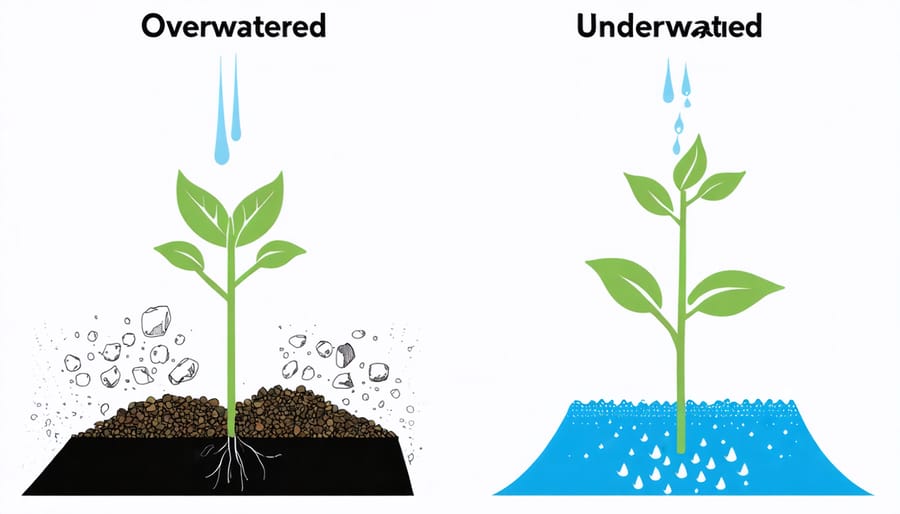
Dealing with Uneven Water Distribution
Achieving uniform water distribution can be tricky, but it’s essential for healthy plant growth. Start by observing your garden’s watering patterns – look for dry spots or areas where water pools. One effective solution is installing a drip irrigation system with pressure-compensating emitters, which ensures each plant receives the same amount of water regardless of its location.
For traditional sprinkler systems, consider using multi-stream rotary nozzles that provide more even coverage than standard spray heads. Position sprinklers to create overlapping patterns, typically aiming for head-to-head coverage. This means each sprinkler should throw water as far as the next sprinkler head.
If you’re hand-watering, use a water wand with an adjustable spray pattern. Water in a circular motion, moving from the plant’s base outward to encourage deep root growth. For sloped areas, install terraces or use soaker hoses laid horizontally across the slope to prevent runoff.
Remember to check your soil’s composition too – adding organic matter helps distribute water more evenly throughout the root zone. Regular maintenance of your irrigation system, including checking for clogged emitters and damaged lines, will help maintain consistent coverage.
By implementing these water management techniques in your garden, you’ll not only create a more resilient and sustainable landscape but also contribute to broader water conservation efforts. Remember that successful water management is about finding the right balance for your specific garden’s needs. Start with small changes, like mulching or adjusting your watering schedule, and gradually incorporate more advanced techniques as you become comfortable. Every drop counts, and your thoughtful approach to water usage can make a significant difference. Whether you’re a novice gardener or a seasoned enthusiast, these practices will help you maintain a thriving garden while being a responsible steward of our precious water resources. Keep experimenting, observing, and adapting these techniques to create your perfect water-wise garden.

